Referencing: Concept and Importance
1. Defining Referencing
Referencing is acknowledging the work of others in your writing by adequately
citing sources used to support your ideas. It ensures that the original authors
receive credit and allows others to locate and verify the information presented.
- Example: When writing an education essay, referencing the original works of educational
theorists helps strengthen your arguments and avoids plagiarism.
2. Why Referencing is Important
A. Integrity and Intellectual Property
- Referencing
acknowledges ownership of ideas and respects intellectual property.
- Failing to cite
sources is like committing intellectual theft.
Example: Citing a journal
article when using its ideas in your research prevents plagiarism and respects
the original author's contribution.
B. Building the Foundation of Knowledge
- Referencing connects
your work to the larger body of knowledge, showing how your research fits
within the discipline.
- It ensures academic progress by building on previous work rather than reinventing the
wheel.
Example: Academic progress would be slow and inefficient if every researcher had
to start from scratch without referencing earlier works.
C. Enhancing Credibility
- Referencing
demonstrates that you have thoroughly researched and are familiar with
the existing knowledge base.
- It enhances the
strength of your arguments when they can be traced back to credible,
verified sources.
Example: Referring to research
studies by renowned scholars in your field increases the validity of your own
conclusions.
D. Avoiding Plagiarism
- Plagiarism, or
presenting someone's ideas as your own, is a serious academic offence.
- Proper referencing
ensures that you are not accused of intentional or accidental plagiarism.
Example: Including an in-text
citation and a reference for a paraphrased idea from a book prevents
plagiarism.
3. Types of Sources
A. Primary Sources
- These are original
documents or firsthand accounts of events, research, or experiments.
- An example is an original
research article presenting new findings or a historical diary such as Anne Frank's Diary.
B. Secondary Sources
- These provide
interpretations, analyses, or summaries of primary sources.
- Example: A textbook
summarizing multiple studies on educational psychology.
4. The Ethics of Referencing
A. Quoting vs. Paraphrasing
- Quoting: Directly copying
someone, enclosed in quotation marks, requires precise citation.
- Example:
"Education is the most powerful weapon you can use to change
the world" (Mandela, 1994).
- Paraphrasing: Rewrite someone in your own words, but it still requires citation.
- Example:
Mandela emphasized that education is a critical tool for societal
transformation (Mandela, 1994).
B. Common Misconceptions
- Common Knowledge: Facts widely known
do not need citations but always err on the side of caution.
- Example:
"The earth revolves around the sun" does not need citation.
- Paraphrasing and
Citation: Even when paraphrasing, the original idea still
requires citation to acknowledge its source.
5. Different Referencing Styles
Various academic
disciplines use specific referencing styles, such as:
- APA (American
Psychological Association): Common in the social sciences.
- Example:
(Smith, 2023)
- MLA (Modern Language
Association): Often used in the humanities.
- Example:
(Smith 23)
- Chicago: Used in history
and some other fields.
- Example:
Smith, John. The Study of Education. Chicago: University Press,
2023.
Educators should ensure
that students follow the appropriate style guide for their field.
6. How to Properly Cite Sources
- In-text citation: This involves
placing the source of information within the text.
- Example:
(Doe, 2020) for a book or article.
- Reference list: At the end of the
paper, list all sources used, providing full details.
- Example:
Doe, J. (2020). The Role of Technology in Education. Oxford
University Press.
7. Key Points in Referencing
A. Cite Your Sources Properly
- Always use the
appropriate citation style and be consistent throughout your work.
B. Use Quotation Marks for Direct Quotes
- Clearly indicate
when you are using someone else's words.
C. Paraphrase Effectively
- Reword ideas in your
own language and always cite the source.
D. Keep Track of Your Sources
- Maintain a record of
all references you consult during research using tools like Zotero
or Mendeley.
8. Useful Tools for Referencing
- Zotero: A reference
management tool that helps collect and organize references.
- Mendeley: A tool for
managing citations and creating bibliographies.
- EasyBib: An online tool
that helps format citations in various styles.
9. Referencing Software Benefits
- Saves Time: Automatically
generates citations in the required style.
- Ensures Accuracy: Reduces the chance
of human error.
- Organizes Research: Keeps all
references in one place for easy access.
10. Conclusion
Referencing is not merely
a rule but a crucial part of academic integrity and scholarship. It
demonstrates respect for intellectual property, enhances the credibility of
your work, and helps avoid plagiarism. Educators should instil proper referencing in their students to promote ethical academic practices.
.png)


Comments
Post a Comment